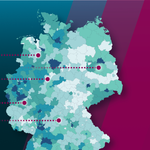How copyright and trademark advocates intend the protection of geographical indications in domain names to be enshrined in EU law
Balsamico di Modena or Côtes de Bordeaux, Thüringer Rostbratwurst or Lübecker Marzipan: Who does not know – and cherish – the often very special culinary delights originating from a certain region or place? Those delicacies that next to their unique characteristics must also be produced entirely or in essential parts in their region of origin, according to a traditional recipe or by a specific production procedure of defined quality level to be allowed to bear their name.
Provided they have been registered in the EU Member State concerned with the competent authority – such as the national Patent and Trademark Office, in Germany – and entered in the EU geographical indications register, eAmbrosia, all pertinent agricultural products and foodstuffs are granted legal protection across the European Union already today by the so-called geographical indication.
The EU Commission now intends to extend this protection to craft and industrial products – and in the future it shall also cover domain names.
The Regulatory Setting
This situation set the framework for the EU Commission to attempt in spring 2022 to further strengthen the property rights of products with a registered geographical indication in the EU Single Market. The reasoning: Such products do not only link economic potential with cultural identity. Due to the products’ high level of quality, consumers also place great trust in them and must therefore be able to rely on effective authentication checks and law enforcement regarding their use and marketing across the entire Union. Given the strong increase in online trade, this must also apply to electronic commerce.
To serve this purpose, the Commission published two proposals for regulations to reform geographical indications. One proposal was designed to amend the existing Regulation on Geographical Indication Protection for Agricultural Products, while the other wanted to extend the protection of geographical indications to craft and agricultural products for the first time ever (Regulation on Geographical Indication Protection for Craft and Industrial Products).
Both proposals included domain names in the future protection range of geographical indications and requested the establishment of a so-called Domain Name Information and Alert System (DIAS) under the auspices of the European Union Intellectual Property Office (EUIPO). The obligations resulting from the proposals, which also contained a corresponding monitoring of registrations and the cooperation with the EUIPO, were meant to be imposed exclusively on ccTLD registries seated in the EU. They would have to prevent, for instance, the registration by third parties of domain strings identical with protected products or delete such domains that had already been registered by a third party or transfer them to the party holding the rights in the product.
The Development in the Course of the Regulatory Process
That was the original proposal made by the Commission. But how has it developed on its way through other EU instances since then? It is true that at EU level, principally only the Commission is entitled to submit draft laws. Since 2007, however, when the Treaty of Lisbon was signed, the European Parliament and the Council of Ministers have become co-legislator with equal rights. This means, that both bodies have to accept the legislative draft before a law can be adopted. If they don’t, as it often initially is the case, a compromise must be negotiated in conciliation committees in the framework of so-called trilogues.
It makes things no easier that different expert committees are responsible for the two legislative proposals on geographical indications at the EU Parliament. As things currently stand, it cannot be ruled out that certain requirements of the domain industry will well apply for agricultural products but not for craft products.
At least for craft and industrial products, the situation preliminarily eased at the start of May, when the results of the interinstitutional negotiations related to these products’ protection became known: The parties had agreed to delete the planned Domain Name Information and Alert System (DIAS) from the text of the regulation for the time being. However, only with suspensory effect since the Commission has a specific reporting obligation: Within the scope of an evaluation test, it must inform the Parliament and the Council within 18 months after the law has entered into force about its effectiveness and explicate on the feasibility of a DIAS for preventing abuse; if necessary, it must present an extended regulation. The negotiated package also provides that European ccTLD registries that have alternative dispute resolution (ADR) methods in place must accept the assertation of rights resulting from registered geographical indications in case of domain disputes. To become effective, the preliminary agreement must be officially adopted by the European Parliament and the Council of Ministers.
Less progress can currently be observed in the process to reach consent with regard to the Regulation on Geographical Indication Protection for Agricultural Products: It is true that the governments of the Member States have defined their negotiation position at the start of May – also for agricultural products they only request to establish or adapt alternative dispute procedures and consider a DIAS as dispensable. According to a plenary decision of 1 June taken on the basis of recommendations of the Agricultural Committee, the European Parliament, in contrast, wants to adhere to the extensive requirements for the domain industry and even add more: The MEPs continue to insist on establishing a DIAS, so that potentially controversial domain registrations can be monitored across the Union by EUIPO. The parliamentarians further want to enshrine the acknowledgement and protection of existing rights in geographical indications for agricultural products in domains not only within the EU, but the members of the Commission even advocate them to apply internationally, at ICANN level and within UDPR arbitration. However, at least both Council and Parliament want to drop the distortive passage of the original draft suggested by the Commission, which would have provided that some regulations applied exclusively for ccTLDs seated in the EU. This now is the basis to start the negotiations with the EU Member States about the final version of the law.
Assessment and Reaction of the Community
At EU level, an increasing number of specific regulatory efforts launched by niche players can be observed. That the ccLTD community wants to counteract this trend with vigour was underscored again only recently at this year’s CENTR Jamboree. The Jamboree is the annual meeting of the association of European ccTLDs, in which DENIC, too, has been active since CENTR was founded in 1998.
In September 2022, CENTR published a comment on the planned geographical indications reform in the EU in the name of its members and submitted it to the competent Directorate-general of the Commission. This document explains why the European ccTLDs, who have had effective protective instruments and procedures against unlawful domain registration in place for a long time, see no need for the planned regulations. In addition to data protection reservations, the members of CENTR also have a critical view on the outlay that would result from such measures for individual market participants.
An independent study commissioned by CENTR in November 2022 and published in January 2023, additionally investigated the low number of disputes on designations of origin that have occurred until now in the individual EU Member States. All of them could be settled by already established alternative dispute resolution (ADR) procedures and thus prove the over-regulating effect of the planned law. In Germany, there has been only one single case so far that went to court.










